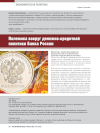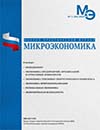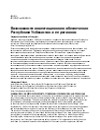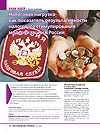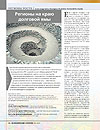Debates Around the Monetary Policy of the Bank of Russia
DOI: 10.33917/es-2.188.2023.50-55
Examines the monetary policy features in the context of the investment agenda. Current policy of the Bank of Russia is analyzed. Business profitability accounting in the monetary policy of the financial regulator contribute to the growth of Russian companies’ investment activity.
References:
1. Lutsenko S.I. Dokhodnost’ biznesa i denezhno-kreditnaya politika [Profitability of Business and Monetary Policy]. Strategicheskie resheniya i riskmenedzhment, 2022, no 4, pp. 326–332.
2. Konstitutsiya Rossiiskoi Federatsii (prinyata vsenarodnym golosovaniem 12 dekabrya 1993 g. s izmeneniyami, odobrennymi v khode obshcherossiiskogo golosovaniya 1 iyulya 2020 g.) [The Constitution of the Russian Federation (adopted by popular vote on 12/12/1993 with amendments approved during the all-Russian vote on 07/01/2020)]. Ofitsial’nyi sait Prezidenta RF, available at: http://www.kremlin.ru/acts/constitution.
3. Opredelenie Konstitutsionnogo suda RF ot 14 dekabrya 2000 g. no 268-O [Determination of the Constitutional Court of the Russian Federation of December 14, 2000 No. 268-O]. Vestnik Konstitutsionnogo suda RF, 2001, no 2.
4. Opredelenie Konstitutsionnogo suda RF ot 15 yanvarya 2003 g. no 45-O [Determination of the Constitutional Court of the Russian Federation of January 15, 2003 No. 45-O]. Vestnik Konstitutsionnogo suda RF, 2003, no 3.
5. Federal’nyi zakon ot 10 iyulya 2002 g. no 86-FZ “O Tsentral’nom banke Rossiiskoi Federatsii (Banke Rossii)” [Federal Law of July 10, 2002 No. 86-FZ “On the Central Bank of the Russian Federation (Bank of Russia)”]. Sobranie zakonodatel’stva RF, 2002, no 28.
6. Osnovnye napravleniya edinoi gosudarstvennoi denezhno-kreditnoi politiki na 2023 god i period 2024 i 2025 godov (utv. Bankom Rossii) [The main directions of the unified state monetary policy for 2023 and the period of 2024 and 2025 (approved by the Bank of Russia)]. Konsul’tantPlyus, available at: https://www.consultant.ru/document/cons_doc_LAW_430425.
7. Informatsiya Banka Rossii ot 24 maya 2019 g. “MVF nazval targetirovanie inflyatsii i gibkii obmennyi kurs odnimi iz klyuchevykh predposylok dlya povysheniya potentsiala rosta rossiiskoi ekonomiki” [Information from the Bank of Russia dated May 24, 2019 “The IMF called inflation targeting and a flexible exchange rate one of the key prerequisites for increasing the growth potential of the Russian economy”]. Vestnik Banka Rossii, 2019, no 34.
8. Informatsionnoe soobshchenie Banka Rossii ot 21 noyabrya 2019 g. “Missiya MVF zayavila o vazhnosti sokhraneniya v Rossii prochnoi makroekonomicheskoi osnovy” [Information message of the Bank of Russia dated November 21, 2019 “The IMF mission declared the importance of maintaining a solid macroeconomic foundation in Russia”]. Vestnik Banka Rossii, 2019, no 74.
9. Prikaz Minsel’khoza Rossii ot 19 marta 2014 g. no 83 “Ob utverzhdenii otraslevoi tselevoi programmy “Razvitie khlebopekarnoi promyshlennosti Rossiiskoi Federatsii na 2014–2016 gody” [Order of the Ministry of Agriculture of Russia dated March 19, 2014 no. 83 “On approval of the sectoral target program “Development of the baking industry of the Russian Federation for 2014-2016”]. Konsul’tantPlyus, available at: https://www.consultant.ru/cons/cgi/online.cgi?req=doc&base=EXP&n=582610#8c8RoZTUXZLWGs3n.



